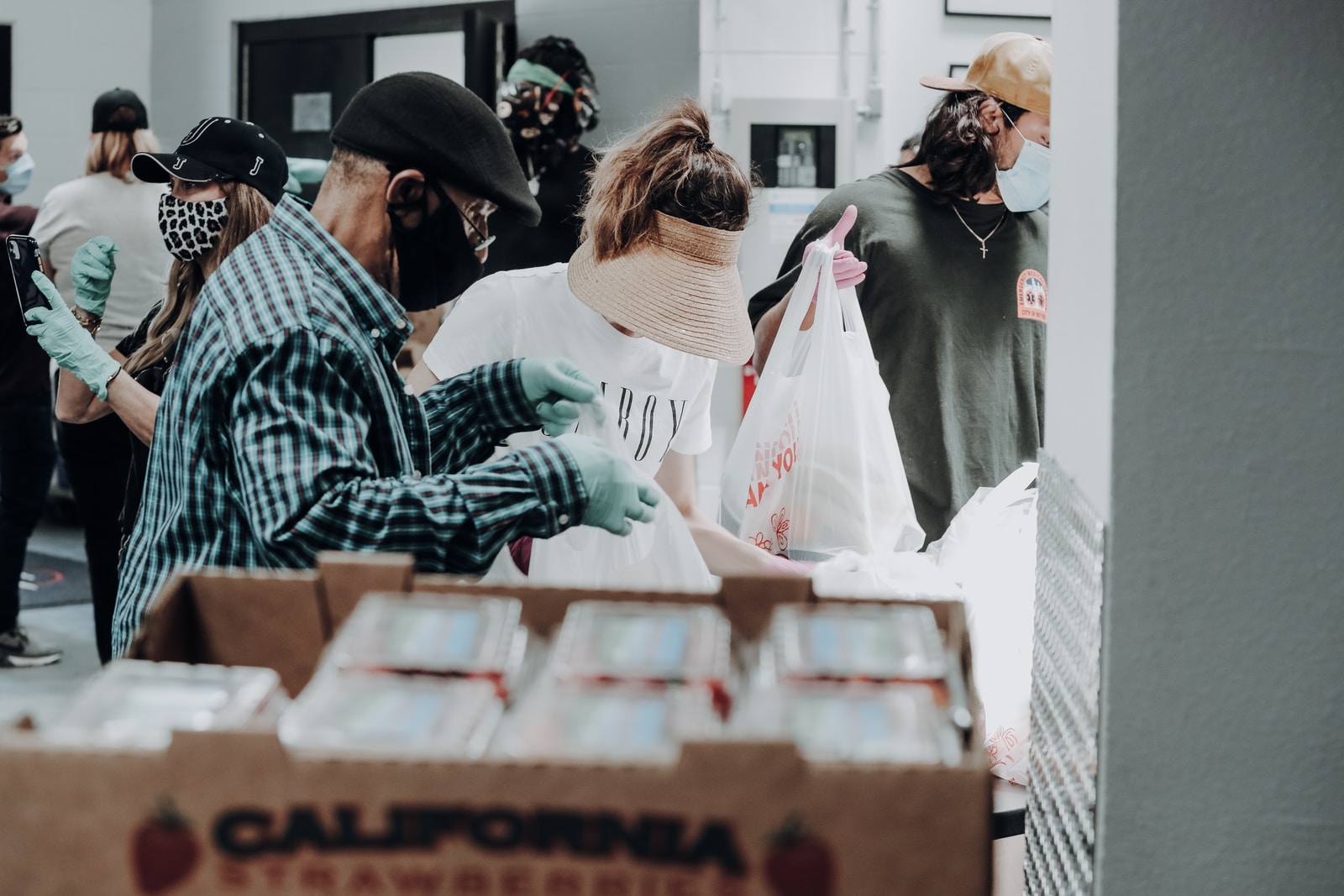

In the wake of the coronavirus crisis, communities across central Minnesota faced new challenges and found new strengths.
Surrounded by thousands of surface miles of lakes, boreal forests and natural beauty, the community of the Leech Lake Band of Ojibwe (LLBO) also lies in the middle of a food desert, with few options for doorstep deliveries or quick trips to the grocery store.
“With the lay of the land up here, and no major metropolitan areas around, most folks have to drive upwards of 50 miles just to get the basics,” said Mike Auger, LLBO’s director of gaming operations. “As the COVID-19 pandemic started up, we decided we needed to tackle the problem of food insecurity in our community, because it was also one of the ways we thought we could keep our elders safe at home.”
In March, the Leech Lake Band Emergency Management Team launched the COVID-19 Food Initiative, distributing 700 boxes of pantry staples around the region. “The only qualification for getting the food box was needing it,” said Auger, who oversaw the distribution operation. “We didn’t care if you were a band member, or if you were white, or what your income was. We just got the food out where we thought people could use it.”
As the statewide shutdown continued, and organizers learned more about the community’s needs, LLBO’s COVID-19 Food Initiative grew more ambitious, activating nearly 100 volunteers and working with a nutritionist to ensure that every box contained a healthy range of shelf-stable foods and personal products to nourish families at home. Working with CARES Act funding from the state of Minnesota, supply chain support from Teal’s Market, the local grocery store, and grant funding from the Initiative Foundation and other partners, LLBO has continued its commitment for a full year, delivering nearly 16,000 boxes of food around the region since the start of the pandemic.
“Our goals at the start were just getting through the immediate future,” said Auger. “Like everyone last March, we never anticipated that we’d still be doing this the following March.” He credits collaborations with Second Harvest Heartland, the state of Minnesota and a host of other partners for helping the band “cut through red tape and make a huge difference to people during a tough time. Food security was an issue before the pandemic, but now that the problem’s been brought to the surface, I think we’ve seen there are solutions that can help solve it. I hope that’s the lesson we’ll take from this after the pandemic ends.”
ESSENTIAL NEEDS
The Leech Lake Band of Ojibwe’s COVID-19 Food Initiative is one of more than 1,400 nonprofits and businesses the Initiative Foundation helped to fund in 2020, the biggest and the busiest year in the organization’s 35-year history. “We were founded in the wake of the farm crisis, so we pride ourselves on being prepared for challenges, but it would be an understatement to say this is not the year we had planned,” said Don Hickman, Initiative Foundation vice president of community and workforce development. While the Foundation stepped up its grantmaking, nearly quintupling the dollars it awards in a typical year, the needs across the region were even greater.
“We have a long history of funding capacity building and strategic planning and things that will set communities up for longterm success, but this year, for the first time, we decided we had to directly fund the service of essential needs,” said Hickman. “With grant requests outstripping available resources by more than a 10:1 ratio, we had to make some tough choices and focus on the needs that were most acute.”
For instance, as communities with meat processing plants emerged as COVID-19 hot zones, the Initiative Foundation reached out to underserved communities in Cold Spring, Long Prairie and Melrose by hiring two bilingual disaster response specialists to ensure that employees, often from Latino and Somali communities, had the information they needed to stay safe in the workplace and to access other essential services during the pandemic. The effort resulted in the delivery of nearly $1.2 million in support to the designated communities. (See the story Serving the Underserved).
With hundreds of small businesses forced to close during the shutdown or to find new ways of meeting customers, the Foundation also administered $7.66 million in small business relief grants in partnership with the Minnesota Department of Employment and Economic Development (DEED), which helped to provide $10,000 grants to 766 small businesses in the region. The effort, funded by federal CARES Act dollars, also included a special allocation of $110,000 for a St. Cloud cultural mall and its tenants. (See the story A Place for Community).
With a serious child care shortage already in place, and essential service workers pressed for solutions, the Initiative Foundation also helped to fund a new accelerated early childhood certification program at Pine Technical & Community College, one of several “one year to a new career” programs that have surfaced to help reactivate workers laid off during the shutdown. These programs also solve labor shortages that were a problem before the pandemic.
All totaled, the Initiative Foundation infused more than $14.2 million in relief efforts throughout Central Minnesota.
“It’s remarkable that the economy is doing as well as it is in spite of a global pandemic, and for that I think we can thank lots of diligent entrepreneurs, and the fact that governments and the philanthropic community are stepping up. It’s taken everyone working together to take on this challenge,” said Initiative Foundation President Matt Varilek.
FUTURE SOLUTIONS
The last year of shut-downs, school closures and supply chain challenges have also revealed trouble spots in Central Minnesota’s economy. “Even though the economy is strong in aggregate, it also reflects some pretty vast disparities,” Varilek said, noting that while hospitality and personal service businesses have been devastated by the pandemic, other sectors like construction, outdoor recreation and some manufacturing have seen big gains. “Some businesses in the region have had their best year ever, while others are in danger of going away for good.”
Jeff Wig, the Initiative Foundation’s vice president for entrepreneurship, agrees. “When the shutdown started there was a shock and awe phase last spring and summer that has given way to an adjustment phase as people found new ways of doing business.” For instance, favorite local restaurants revved up websites and offered deliveries and curbside pick-ups, while other operations make quick pivots, like Brainerd’s The Teehive, a custom T-shirt shop that quickly began producing face masks and other personal protective garments. While the Paycheck Protection Program and other small business loan programs have offered a lifeline to many small businesses in the region, “giving people additional loans for emergency use is not always what they want,” Wig said. “There are many other businesses that have decided it’s not worth it to stay open and lose money, but they’re looking for a way to grow forward as we start to emerge from the COVID-19 tunnel.”
BACKING BUSINESS: From Gustaf’s Up North Gallery in Lindstrom (upper left) to Jordie’s Trailside Cafe in Bowlus (upper right) to Lupulin Brewery in Big Lake (lower left) and GroShed located in Emily (lower right), grants distributed by the Initiative Foundation helped bring relief to regional small businesses.
Child care surfaced as another major challenge, as homes or centers closed or reduced class sizes and parents took on teaching duties at home. “Problems with finding or hanging onto child care is the single biggest factor affecting an employee’s productivity and the single biggest reason for absenteeism. The pandemic made that painfully clear,” said Marnie Werner, vice president for research and operations at the Center for Rural Policy and Development. “If you were having problems with child care, particularly in rural communities, you might be able to fall back on grandma or an aunt in a pinch, but with COVID, you can’t rely on your older relatives, which cut off that avenue for patching the problem.”
In a tight job market, employers could replace a child-care challenged employee with a new hire. But there are more unfilled jobs than skilled workers in the region, a trend that’s continued through the pandemic. “Businesses are starting to realize and understand that they do have to get involved in solving this problem,” said Werner. “And for policy makers and the public in general, I think this year has really clarified how much child care is part of the infrastructure that supports economic growth.”
With widespread vaccine distribution now within view, Varilek says a strong recovery for the region will also depend on following the public health lessons we’ve learned over the last year. “The health of Central Minnesota’s economy and the coronavirus are closely connected,” he said. “Fortunately, this virus is beatable and we’ve learned how to operate our economy more openly than we did in the early days. But getting to the next stage of the new normal is going to depend on as many of us as possible getting vaccinated just as soon as we can.
“We shouldn’t get ahead of ourselves in terms of our expectations about immediately getting together in large groups, traveling for work and leisure and other things we’ve missed during the pandemic, but the fact we’ve been able to maintain the economic strength we’ve seen during this year gives me great optimism,” he said. “If we’re doing as well as we are with all of these pandemic constraints in place, just imagine where we can be in the future.”
